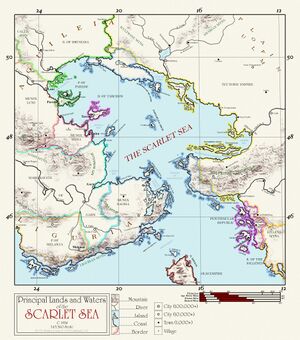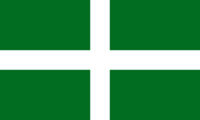The Scarlet Sea
History of the Scarlet Sea[edit | edit source]

- The Etruscan League defeats and absorbs the Latin League.
- The Etrurian Empire rises to power and conquers many of the regions around the Tarquinian Sea.
- The Great Flood devastates the world, and weakens the Etrurian Empire greatly. Avar barbarians rampage westwards and seize much of Europe. The influence of the Etrurian civilization leads to the creation of the priestly Cycles, which survive the Collapse and shape the Avarene culture.
- The Scarlet Sea expands greatly due to the Great Flood.
- Lunitic Channel and Wulfenfang Channel are created.
- Lesser Tsipolania is split from Greater Tsipolania.
- The Teutonic horde follows the Avars and lays waste to many of their khanates. Adopting the Cyclic model, the Teutonic princes are able to avoid the in-fighting and rivalries that weakened the Avarenes by establishing an elective monarchy.
Nations of the Scarlet Sea[edit | edit source]
| Flag | Description |
|---|---|

|
The Fraternal Empire of Teutonic Princes: Some form of Teutonic Empire has ruled Eastern Europe since the fall of the Etrurian Empire. This latest incarnation seems to be writing the final chapters of its 600-year long history, as its ruling princes find themselves fighting rebellions in the streets and marauding warlords in the forests. The empire’s Reichsrings, the groupings of subject states into larger bodies for taxation and defense, seem to quail before revolutionaries preaching the seizure of factories or the liberation of cultures. The throne of the Prince-Emperor sits vacant, the victim of the Teutonic Empire’s defeat in the Great War, and opportunities call for mercenaries, pirates, and demagogues to seize them. |
| Kingdom of Drusiana: The Kingdom of Drusiana is the seat of the Great House of Hans-Elbe, one of the three Teutonic Houses to produce multiple Emperors in the last 400 years. Formerly an independent kingdom, Drusiana was incorporated into the Teutonic Empire by marriage and has managed to maintain separate institutions of government, including a separate army, and fared far worse in the Great War than the Empire as a whole. As a result, the burgeoning Drusian independence movement has lost influence and grown more desperate, a situation that feeds the pirate and smuggler networks which infest its relatively unguarded coasts. | |

|
Principality of Parede: Newly-independent in the wake of the Great War, Parede was the gem of southern Drusiana. Though separated from its motherland by the Lunitic Channel, Parede was the kingdom’s commercial heart and its gateway to the Scarlet Sea. That wealth and importance birthed a vision of a free and independent Drusiana, one finally rid of an Empire willing to sacrifice the kingdom on the fires of war. One bloody rebellion later, settled by the invasion of the triumphant Allied Powers, and this sole peninsula was given its liberty. Governed by a rebellious son of the House of Hans-Elbe, intrigue and plots flourish among warehouses and crowded piers, hoping to export the Principality across the channel. |
| Margravate of Garn: A powerful and wealthy princedom of the Teutonic Empire, the Margravate was initially founded to counter the Avarene invasions of southern Tyrnia. Formed from the remaining Teutonic holdings, themselves won in the Teutonic invasions of the Etrurian Empire, the Margravate played a critical role in the survival of the Teutonic Empire and would become the dominate power of Tyrnia for several centuries. Though an integral part of the Empire, its people, admixtures of Teutonic, Tyrnian, and Avarene blood, have remained aloof from their cousins across the sea. In the wake of the Great War, where Garnian soldiers fought bravely and bloodily for a defeated cause, the Margravate’s artists, poets, and writers have built a nascent national myth of Garnian identity. | |
| Most Serene Republic of Nacria: One of the most powerful city-states on the Tyrnian Peninsula, Nacria exploited the Great War to dominate the trade of Europe. 80% of all European trade is carried on Nacrian-flagged vessels and airships, and the Republic often acts through mercenary catspaws to protect that dominance. The wealth of Nacria has made it a center of engineering and financial innovation, and in older times the Republic ruled a sea-girt empire throughout the Colleterrean Sea. Now, much reduced but far wealthier, the Republic has won territory throughout the Scarlet Sea thanks to its late-war turn from neutral to Ally. But in its triumph it has to contend with newly rebellious subjects, and a growing turn towards Tyrnian nationalism and unification threatens the very existence of the Republic. | |
| Principality of Melanza: Melanza is a land of fertile fields and sheer, hand-cut mountains. Long conquered by the Margravate of Garn, the Republic of Nacria sponsored and led a revolution that restored the long-exiled (and Nacrian) princely house to the city-state’s throne. Melanza is one of the strongest opponents of Tyrnian unity, but the region’s poor industrial base means it relies on its Tyrnian neighbors for capital and trade. | |
| Most Serene Republic of Luni: Threatened by its neighbors and divided in its leadership, the Republic of Luni survives through the support of its former rival and fellow city-state, Nacria. While the Kingdom of Caltiberia exports propaganda calling for Tyrian unification, Luni struggles to justify its place in the peninsula, divided as it is between a Tyrnia majority and a substantial Teutonic Drusian minority. Despite being one of the Allied Powers in the Great War, it won few concessions from the defeated Teutons, and its mountainous southern border remains locked in a shadowy civil war between Teutonic and Tyrnian nationalists. Its inability to keep the peace has allowed the Banda Mali to dominate its Munix, accentuating its woes. | |
| Free City of Spina: Before the war, Spina was a moderately-wealthy city-state, famous for the fine wines produced by its bountiful vineyards. Those same vineyards were the battleground for some of the most devastating battles fought in the early years of the Great War. Now impoverished, Spina’s remaining territory is divided into a patchwork of bandit fiefs, Garnian “leaseholds”, and revolutionary communes. The city has been heavily depopulated, leaving it at the mercy of criminals, creditors, and a few hardy magnates increasingly indebted to Tarchonese and Nacrian bankers. | |
| Grand Duchy of Tarchon: The last remnant of the Arslan Khaganate, the Grand Duchy continues to be ruled by the descendants of the Avarene mercenaries which seized it from the remnants of the Etrurian Empire. The ruling house of Tenghiz sponsored the creation of the Universita di la Guerra, the first institution of military study in the world, and as a result Tarchon has become a byword for military genius and reliable mercenary services. Its extensive international connections have also made it a major financial center for transactions in Southern Europe. Though only lightly touched by the Great War, Tarchon stands to profit from its destabilizing aftereffects, particularly in the recovery of its wayward colony, Spina. | |
| Republic of the Five Islands: Once a puppet of Nacria, the Pentinsular Republic now has powerful allies in Astora and the United Kingdom willing to guarantee her independence. Distinguished from their Iollene brethren by race and creed, the republic is not willing to give up their newfound independence to heathen neighbors ruling from a distant capital. | |
| Kingdom of the Iollenes: The powder-keg of Europe which sparked The Great War. Having won independence from the Olm Empire, its cities are being torn apart by socialists, monarchists, anarchists, republicans, and militarists looking to seize the reins of the kingdom's future. | |
| Republic of Gremma: A breakaway region of the Teutonic Empire, granted provisional independence by treaty following the Empire's defeat in the Great War. The majority of the populace are North Iollenes, culturally and ethnically close to the Iollenes of the Iollene Kingdom but with less Olmec influence. The failure of the Osthafen plebiscite to win the Gremma access to the Scarlet Sea was the direct trigger for a general uprising and ethnic purge of the region's Teutonic population, causing widespread unrest and a counter-cleansing by neighboring Teutonic princes. Worse still, the Iollene Kingdom continues to pursue reunification with Gremma, threatening war with the Pentinsular Republic and Teutonic principalities. | |
| The Olm Empire: One of the Central Powers, the Olm Empire is also falling apart in the wake of The Great War. Ambitious ketzals and calpuehs deny the distant authority of the Jaguar Throne, and long-downtrodden slave races rise up and wage bloody wars. For those willing to brave the treacherous and decadent lands of the Olmecs, the treasures of Africa and the Orient are there for the taking. | |
| Khiimori Khaganate: Formerly located to the east of the Teutonic Empire, the Khaganate is in the midst of a violent revolution driving streams of Temurian refugees into Europe. Effective rule of the Khaganate no longer exists, though the largest faction of revolutionaries claims the entirety of its old territory. Ambitious Teutonic princes and remnants of the Khiimori aristocracy contest that claim. |
Other Factions[edit | edit source]
The Scarlet Sea is home to powers other than nations. Rebellious nationalists, workers councils, religious hierarchies and more compete for power, wealth, and influence across its waters.
The Immortal Azure Khanate[edit | edit source]
The largest single Cycle in the Western world, unique in its monotheism. The followers of the Azure Khan can be found in the furthest islands of the west to the coldest steppes of the east, in towering forests of the New World and sweltering jungles of the Old. Within the bound of the Sapphire Sea, the cycle is strongest in the Grand Duchy of Tarchon, where it has the status of state religion.
The Bardic Colleges[edit | edit source]
The collective term for the hierarchies of priests, druids, shamans, and clerics of the European Cycles. The largest and oldest bardic college is the College of Ulm, the heart of Teutonic faith, but many cycles have copied its structure and organized themselves in a like manner. These faiths are invariably polytheistic, claiming descent from the most ancient traditions of their people. Though fractious and divided, on the whole they remain implacably opposed to the Immortal Azure Khanate and its exclusive claims to divinity. Formal colleges are rare outside of Europe, though reformist factions of other religions have promulgated their adoption. The Scarlet Sea is home to several prominent colleges, largely thanks to its history as the frontier of ancient empires.
College of Ulm: The oldest, wealthiest, and most powerful of the Colleges of Europe, the Wodanic College of Ulm governs the spiritual and cultural life of the Teutonic Empire. Ruled by the Prince-Bard of The Holy City, the college has spawned numerous subordinate colleges in nations throughout Europe to serve Teutonic migrants and local converts. Centuries of preaching, often backed by the force of the Empire's armies, has ensured it a dominant position in the field of European religion.
College of Nacria: A relatively young college, founded only after the first flowering of Nacrian power in the mid-1400s, the Collegium Pontificum nourishes a decayed branch of the ancient Tyrnian faith. Whether rediscovered or reinvented, it is a regional rival to the Wodanic Cycle that professes faith in the gods of the Reman Empire.
College of Meteora: Following the Iollene Revolution, the College of Meteora is now the dominant hierarchy of the Dodekan Cycle. While many of the structures of the former Katunic college have been torn down, debates over the future of the long-suppressed Dodekan faith have kept the college from establishing itself in the Vale of Meteora itself. Its faithful practice in town squares and converted basements, celebrating their renewed faith and revealing long-hidden temples that survived the persecution of their Olmec overlords of yore.
College of Lordran: Prominent in the region of the Caltic Alps, the Bardic College of Lordran was the first to employ the term "bards" for its various practitioners. Such was its influence across Western Europe that the term became synonymous with the Colleges as a whole, though its Bardic Cycle is largely limited to the lands and colonies of Western Europe.
College of Erikslund: Represented by a few shrine-temples in Nacria, Silberwasche, and other coastal cities, the Bardic College of Erikslund is primarily patronized by Danish sailors working ships far from home. Worshipping a Danish offshoot of the Bardic Cycle, it is both brother and rival to the College of Lordran, a situation common in Western Europe.
College of Tzi'tzu'unun: Situated in the prominent Olmec port of Tzi'tzu'unun, this college's branch of the Katunic Cycle is the most widely recognized in the region of the Scarlet Sea. This has made the college a target of much intrigue by more traditionalist ketzals of the Olm Empire. In the Scarlet Sea, its stronghold has always been the island of Greater Xipolia. Efforts to establish dominance over the Katunic faithful of the Iollene Peninsula have largely been rebuffed by the Iollene Katuns, who established their own college in the ancient religious heartland of the Vale of Meteora.
College of Corfu: Founded by priests fleeing the Iollene Revolution, the Corfu college serves followers of the Katunic Cycle within the Pentinsular Republic. Once largely independent, it is at great risk of being absorbed into the College of Tzi'tzu'unun due to the overthrow of the Ioxic Ketzalate.
Banda Mali[edit | edit source]
An organized crime syndicate reputed to have existed since the 11th Century in the lowlands and foothills of the Caltic Alps.
People of the Scarlet Sea[edit | edit source]
Avarenes[edit | edit source]
A historic ethnic group, long absorbed into the modern nationalities of the Scarlet Sea. The Avarenes arose from several coastal enclaves of the Avar barbarians, and their intermixture with indigenous Teuto-Remans. Their cultural and military influence spread from these enclaves to encompass much of southern Europe, and would have lasting effects on the systems of law, governance, and language throughout the region. While many of the Avarene people now identify as Tyrnians, Teutons, and other nationalities, the Grand Duchy of Tarchon claims an unbroken line of descent in custom, law, and blood from the Avarene Arslan Khaganate, making it the sole remaining Avarene state.
Olmecs[edit | edit source]
An African race, the European term "Olmec" actually covers a broad swathe of related races living in northern Africa and Western Asia. The true Olmecs are the dominant race of the region, but make up only 30-40% of the population of their vast and rebellious empire.
Teutons[edit | edit source]
Iollenes[edit | edit source]
Tyrnians[edit | edit source]
Venes[edit | edit source]
A Teutonic race that was settled along the medieval Ellsmark, the Venes populate much of the Wulfenfang Peninsula.
Astorans, Danes, and Other Minor Peoples[edit | edit source]
Astorans[edit | edit source]
The Astoran people are a race of ancient admixture, descended from Gauls, Etrurians, and Teutons who populated Western Europe in the time before the Great Flood. In the Scarlet Sea, they are divided into several small ethnic groups in the Caltic Alps, their easternmost-point of expansion in prior days, or as sailors and pilots in large cities.
Danes[edit | edit source]
Etrurians[edit | edit source]
Hessens[edit | edit source]
Moravians[edit | edit source]
Roslanders[edit | edit source]
Swabians[edit | edit source]
Wallachs[edit | edit source]
Locations of Note[edit | edit source]
Meersgrünau: This small fishing village was once famous for the fields of green seagrass and herds of sea turtles that can be found in the waters about its island. Now it is better known as an idyllic hotspot for pilots, engineers, and seaplane fancies.
Ulm: Capital of the Teutonic Empire